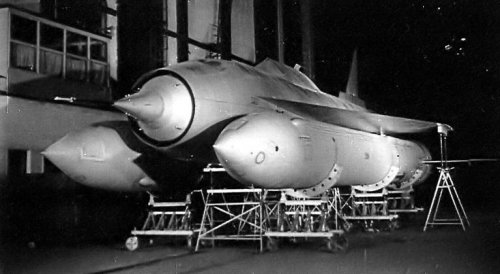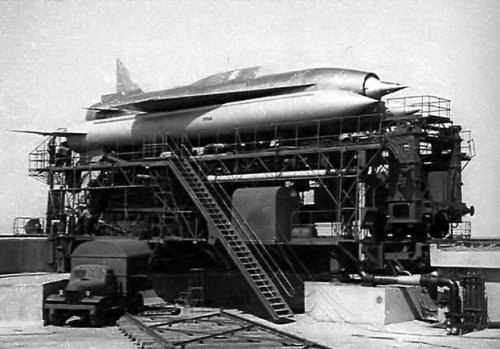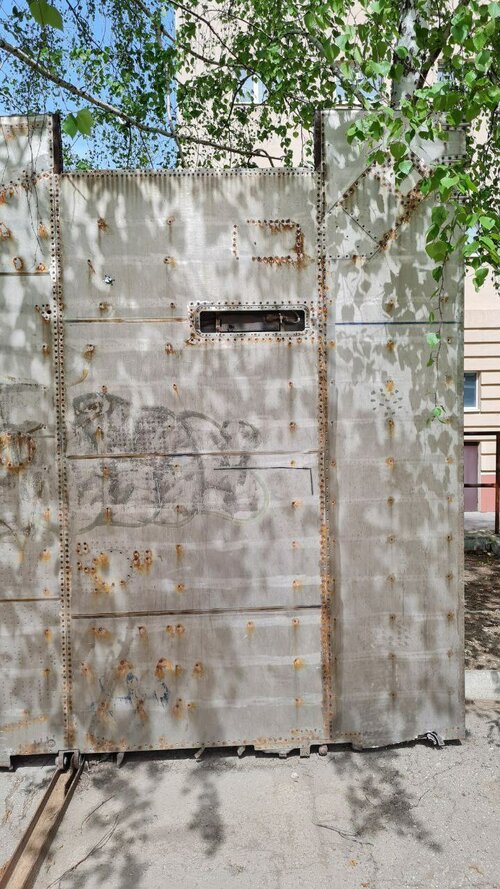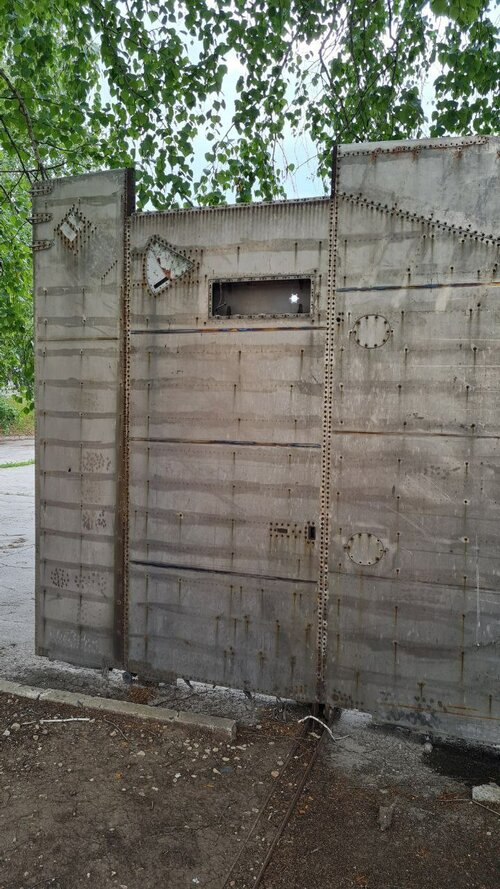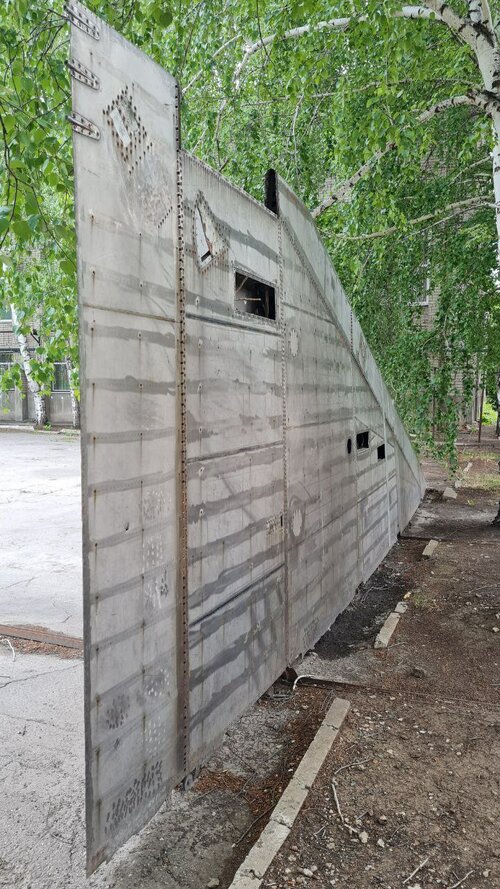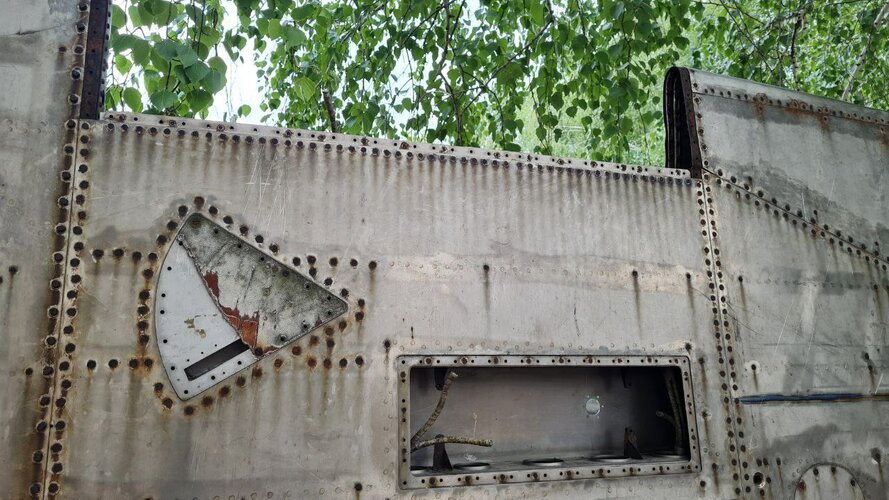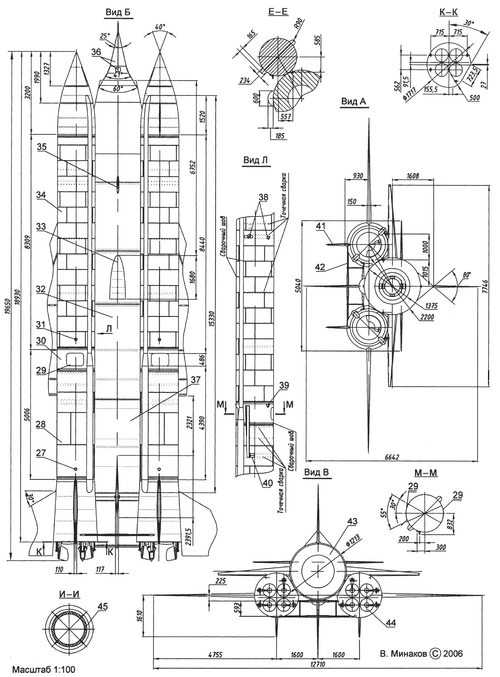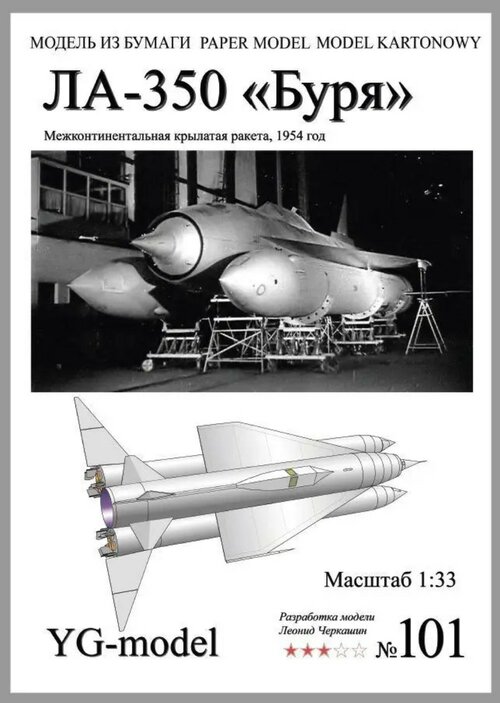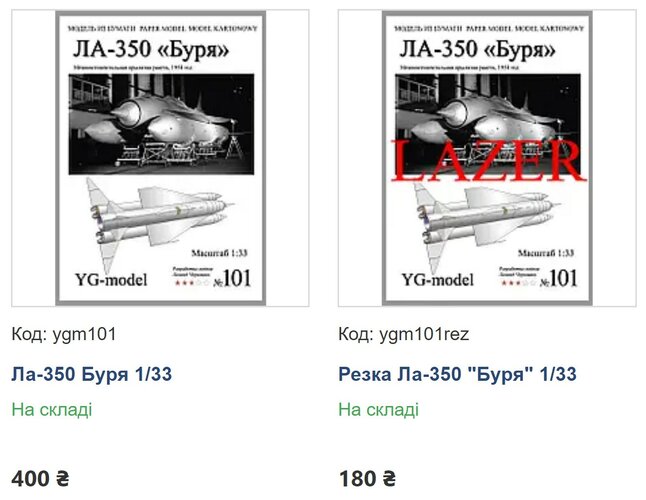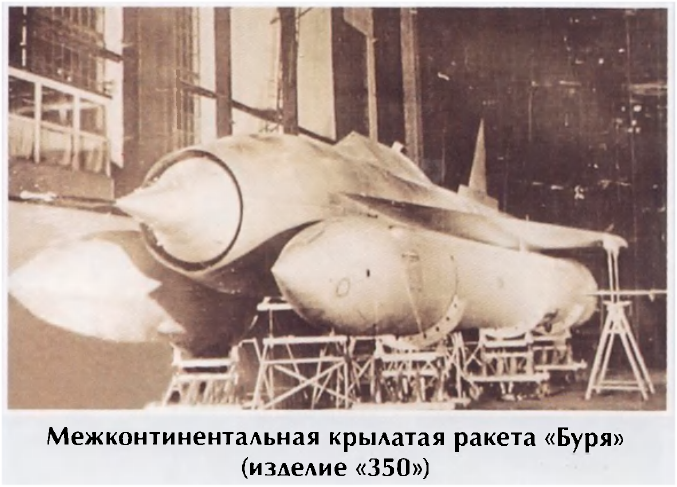ÑÑÑаÑегиÑеÑÐºÐ°Ñ ÐºÑÑлаÑÐ°Ñ ÑакеÑа «350» «ÐÑÑÑ» ÐÐРС.Ð.ÐавоÑкина

testpilot.ru
In view of the employment of OKB-1 NII-88 with work on the creation and development of R-5 and R-7 combat missiles, after the Decree of the Council of Ministers of the USSR of May 20, 1954, the subject of long-range cruise missiles was transferred to the Ministry of Aviation Industry. OKB-301 chief designer S.A. Lavochkin and OKB-23 chief designer V.M. Myasishchev . Decree of the Council of Ministers of the USSR of May 20, 1954 N957-409 assigned the development of two types of intercontinental projectiles to destroy targets in the United States. The search work of the design teams was named "KRMD" - an intercontinental-range cruise missile.
The results of the topic "KRMD" were used in the development of complexes with the intercontinental cruise missile "Burya" (product "350", V-350, La-350) in OKB-301 and with the MKR "Buran" (product "40") - in OKB-23. Mstislav Vsevolodovich Keldysh, director of NII-1, academician, future president of the USSR Academy of Sciences, was appointed scientific director of the Burya and Buran projects. He was a member of the Royal Council of Chief Designers, was well acquainted with the results of the development of an experimental cruise missile, was the most informed scientist on all the most important scientific and technical problems that needed to be solved when creating nuclear weapons carriers.
Naum Semenovich Chernyakov was appointed chief designer of the Burya cruise missile at Lavochkin (later he was chief designer of the T-4 OKB at P.O. Sukhoi ). Among the most important and complex technical problems solved in the process of preparing the "Burya" and "Buran", one can note the creation for them of a SPVRD and an astro-navigation system (it was developed by the branch of NII-1, led by Ruben Chachikyan). In addition, titanium was used for the first time on these rockets, a material that was then new for Soviet rocket building. This metal, capable of maintaining high mechanical properties at significant temperatures, proved to be indispensable in long-term flight at high supersonic speeds.
While working on the "Storm" in OKB-301, Semyon Lavochkin was the first in the Soviet Union to develop and implement a technology for welding titanium, as well as some types of mechanical processing of this material. Along with titanium, other heat-resistant materials used for sealing, various coatings, insulation, glazing, etc. were used in the construction of the Burya. Most of them had not been mastered in the USSR by the time the Storm was created, and their introduction went in parallel with the work on the rocket.
The preliminary design of the "Burya" was completed in August 1954. As suggested by Korolev, the rocket was a composite (two-stage). After consideration by the customer, the preliminary design of the rocket was finalized in 1955, the weight of the combat charge was increased from 2.1 to 2.35 tons. This entailed changes in the design and, accordingly, affected the timing of the preparation of the 350 machine. The weight of the MKR increased slightly (the starting weight reached 95,000 kg, the weight of the marching stage - 33,000 kg). Since 1954, for the first stage of the Burya rocket, OKB-2, chief designer A.M. Isaev, has been developing a four-chamber rocket engine C2.1100 with a turbopump fuel supply system. Soon, the production of launch boosters of the first stage at plant No. 207 began. Testing of the aerodynamic scheme of the rocket was carried out on experimental stands at TsAGI and LII in natural conditions on scale models about 2 m long dropped from an aircraft (the work was carried out under the guidance of E.D. Yampolsky).
The "Burya" started vertically from the carriage, then, in accordance with the given program, it passed the accelerating section of the trajectory, on which it was first controlled by gas rudders, then they were dropped and control switched to air rudders. After acceleration, when the flight speed reached the desired value, the SPVRD went into full thrust mode, and at an altitude of 17500 meters the accelerators were uncoupled from the sustainer stage. After that, the flight was corrected using the Earth-type automatic astro-navigation control system. The system was designed for a range of 8,000 kilometers. "Storm" flew at a constant speed, corresponding to M = 3.1-3.2. When approaching the target, the rocket had to make an anti-aircraft maneuver, rise to a height of 25 kilometers and from there dive sharply at the target, and in this mode, the head cone with the warhead was dropped. According to the results of aircraft tests, the probable deviation from the target should not have exceeded 10 kilometers.
The technical documentation for the Burya was completed in 1957, and production of a prototype soon began. In parallel with it, a series of missiles were launched at the factories in Kuibyshev for flight tests.
Flight and design tests of the Burya rocket began on July 31, 1957 at the GTsP-4 (Kapustin Yar). An attempt was made to start. The first launch from a ground-based azimuth-guided launcher (an eight-axle railway platform mounted on a rotary structure) took place on September 1, 1957. At launch, the gas rudders were prematurely reset, the rocket fell and exploded a few seconds later. In the second launch, the rocket exploded in flight at 31 seconds, in the third - at 63 seconds and in the fourth - at 81 seconds of flight. Only on May 22, 1958, in the fifth launch, the rocket stages were successfully uncoupled and the marching SPVRD was launched. Three unsuccessful launches followed.
Specialists had to overcome problems that no one had previously encountered, and deadlines were running out. Already at the end of 1957, work on the Buran was stopped, which did not manage to make a single flight. But for the Burya after certain improvements, the losing streak ended. In the ninth launch - December 28, 1958 - the flight duration was 309 seconds. In the tenth and eleventh launches, record-breaking results for that time were obtained: the rocket flew 1,350 km at a speed of 3,300 km/h and 1,760 km at a speed of 3,500 km/h, respectively. In the USSR, not a single device has ever flown so far in the atmosphere at speeds of the order of M = 3.
In the twelfth launch, a celestial navigation system was installed on the Burya, but it was unsuccessful. In the thirteenth launch, the rocket was equipped with upgraded boosters with C2 engines. 1150 and RD-012U SPVRD with a shortened combustion chamber, the flight lasted about 10 minutes. When launched on December 2, 1959, a rocket equipped with an astronavigation system flew 4,000 km. It was an absolute record. After completing the flight program, the rocket was deployed at 210about and then flew on radio commands. Tests of the rocket along a short track (about 2000 km) have been completed. Testing began on a long track.
One of the participants in those events, Lavochkin's deputy for testing Leonid Zaks, said that somehow an American magazine fell into the hands of the Tempest designers, in which a map of the USSR was presented with marked take-off and impact points, as well as flight paths of domestic long-range missiles . All the missiles were there, except for the Burya. The fact is that NATO had surveillance systems in Turkey that pinpointed the upper part of the flight path of Soviet ballistic missiles. Based on the laws of ballistics, one can easily calculate the rest of the rocket route, the place of its takeoff and fall. But the "Burya" was created according to a different principle, in addition, this rocket could make a maneuver at any given moment, so it was impossible to calculate the entire flight from part of its trajectory, to determine the place of launch or hit. It was also a success.
Meanwhile, the tests continued. The following launches (from the fifteenth to the eighteenth) were made along a long route: the Vladimirovka test site (to the north of the Caspian Sea) - the Kamchatka Peninsula. The last launch, in which the rocket flew 6500 km, took place on December 16, 1960. The SPVRD worked normally, but the fuel consumption was much higher than calculated. The actually obtained circular probabilistic deviation is 4-7 km. The design range of 8000 km was not reached, but the results of these launches led to the conclusion that it is possible to increase the range of the missile. Preparations for mass production have begun.
But by that time, the R-7 intercontinental ballistic missile had already been put into service, and a new R-16 ballistic missile designed by Mikhail Yangel on high-boiling fuel components had entered flight tests. These missiles could overcome any air defense of those years, had a high flight speed, a relatively simple design, etc. It was decided to limit the country's strategic missile fleet to ballistic missiles, and the leadership of the USSR considered it inappropriate to create another carrier.
General designer Semyon Lavochkin tried to prove that it is not worth abandoning a winged aircraft with unique flight and tactical data. He suggested using the Burya as a long-range unmanned reconnaissance photo reconnaissance vehicle or as a target missile.
Although work on the photo reconnaissance began as early as 1958, government decree No. 138-48 on such a development appeared only on February 5, 1960, according to the same decree, work on the Burya as a strategic missile was stopped. The remaining 5 missiles were allocated to work out the photo reconnaissance. However, in June 1960, the general designer died. The reconnaissance project lasted until October, and the targets - until the beginning of next year, but they were also closed. 4 launches of the V-350 were made in the interests of creating a photo reconnaissance and high-speed high-altitude target for the Dal air defense system. The last missile was launched from the Kapustin Yar test site on December 16, 1960 (18th launch). A total of 19 missiles were manufactured and 18 (according to other sources 17) launches were made, of which 3 were emergency.
In 1955-1957 in OKB-301 S.A. Lavochkin, a pre-sketch design of an experimental nuclear cruise missile ( KAR ) with a nuclear ramjet designed by M. M. Bondaryuk was carried out . Work on the 375 rocket did not receive significant development - the CAR turned out to be huge.
On the basis of the groundwork for the Burya, the Design Bureau of Lavochkin and Bondaryuk worked on the creation of an aerospace aircraft and a hypersonic ramjet for it, but after the death of S.A. Lavochkin, the program was discontinued.
In 1956-58, a similar development was being tested in the United States - the NAVAHO G-26 supersonic cruise missiles and the G-38 intercontinental ( North American Aviation ). After 11 unsuccessful launches, the program was closed.

